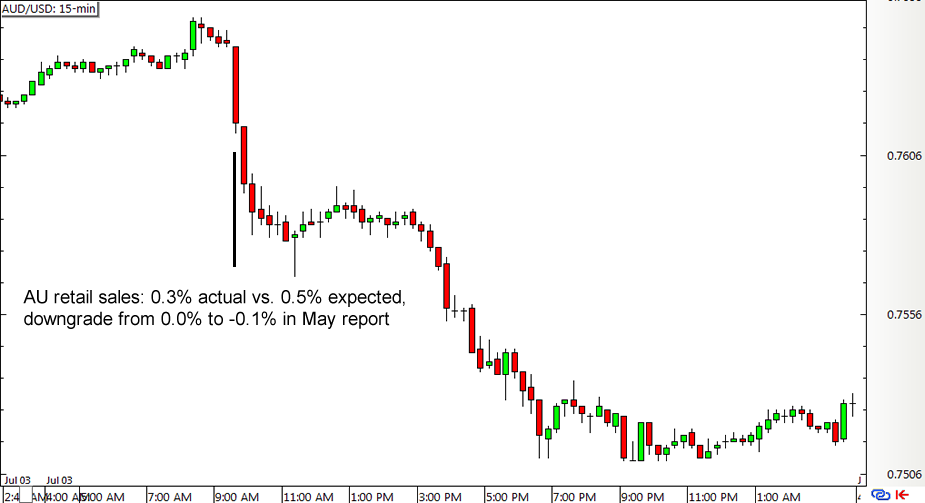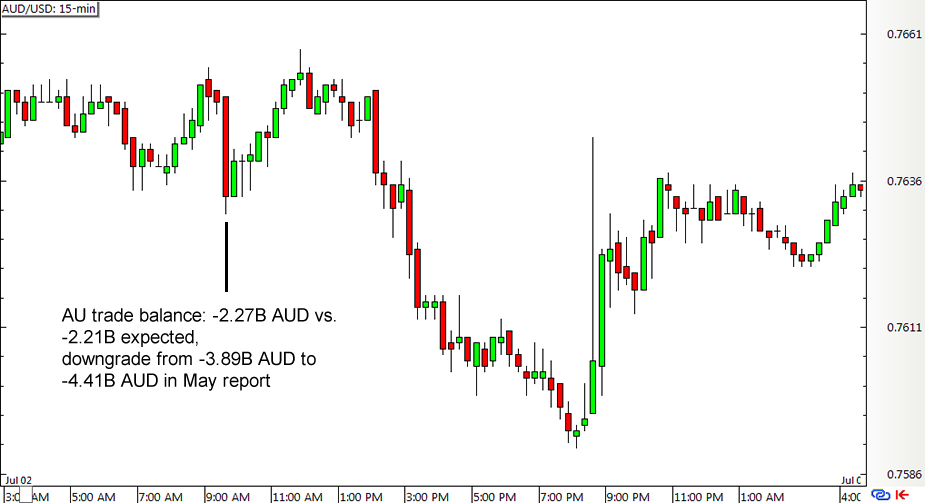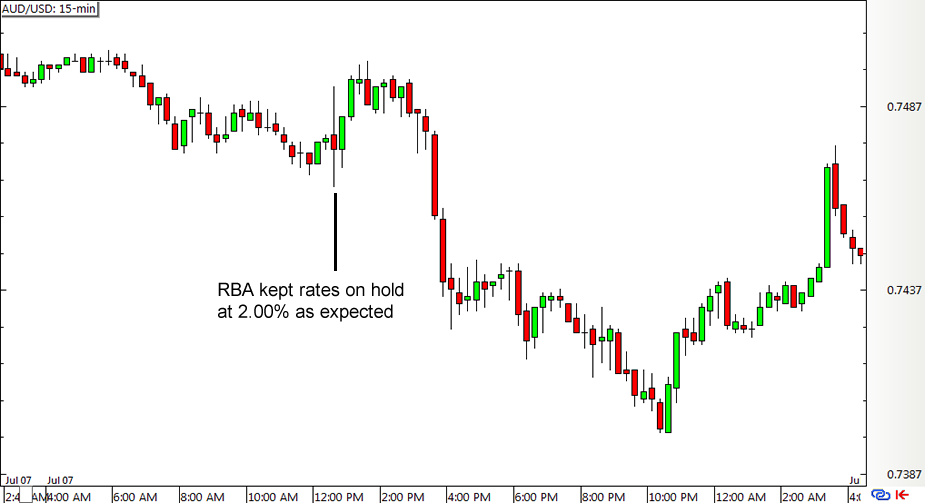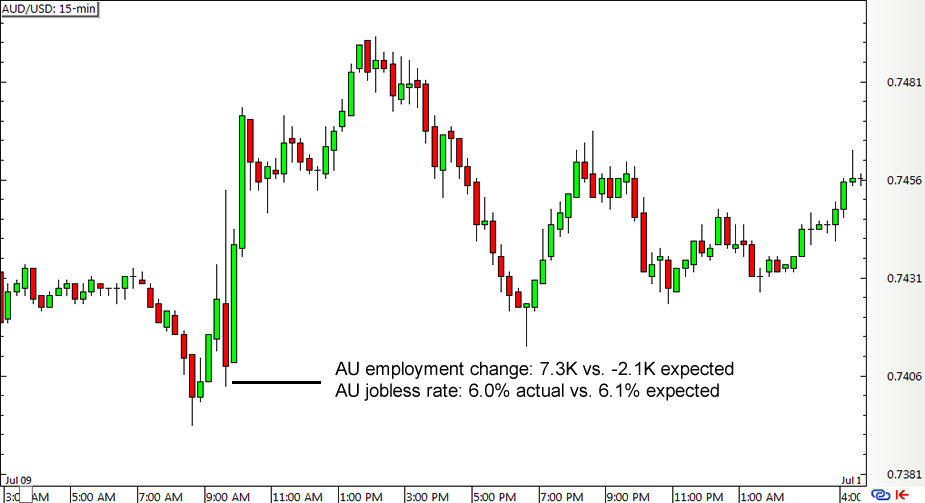1. Retail Sales (Tues, 1:30 am GMT)
The fun starts on Tuesday when Australia prints its retail sales report for the month of June. Analysts are expecting to see a 0.5% increase in consumer spending, higher than the previous month’s 0.3% uptick.
Keep in mind, however, that the retail sales report has been churning out weaker than expected results for the past three releases and that two of those even suffered downward revisions later on. With that, there could be a good chance of seeing another downside surprise this time, which might spur Aussie weakness.
Here’s how AUD/USD reacted during the release of the May retail sales report:

2. Trade Balance (Tues, 1:30 am GMT)
Australia is set to release its trade balance at the same time as its retail sales report on Tuesday, which suggests that the Aussie’s forex reaction could either be magnified or be limited depending on the results. For the month of June, the trade deficit is expected to have widened from 2.75 billion AUD to 3.06 billion AUD, reflecting weaker export activity.
The past three releases have come in below expectations, with a couple of reports undergoing negative revisions and one enjoying a small upgrade. This suggests that the odds are also tilted to the downside for this one, possibly putting more weight on the Australian currency.
Here’s how AUD/USD reacted to the May trade balance report:

3. RBA Interest Rate Decision (Tues, 4:30 am GMT)
Perhaps the biggest event for the Aussie this week is the central bank’s interest rate decision, which is also scheduled on Tuesday. Most market watchers are still expecting RBA Governor Stevens and his gang of policymakers to keep rates on hold at 2.00% for the time being.
Take note that the RBA has already cut interest rates in two instances so far this year so it’s likely that policymakers will continue to sit on their hands and assess the impact of their latest easing efforts. However, the outlook for the Australian economy ain’t looking too good at the moment due to the slowdown in China and another potential drop in commodity prices, which means that a dovish announcement is a possibility.
In their June rate statement, the RBA mentioned that economic growth has been below its long-term average and that unemployment remains elevated but refrained from giving an explicit easing bias.

4. Employment Report (Thurs, 1:30 am GMT)
On Thursday, Australia will release its June jobs report and probably show a 12.5K rise in hiring, a faster pace of increase compared to May’s 7.3K figure. Meanwhile, the unemployment rate is expected to climb from 6.0% to 6.1%.
Three out of the last four releases have beaten market expectations, but the last two ones were downgraded later on, suggesting that the Australian Bureau of Statistics’ labor market estimates should be taken with a grain of salt. That’s probably why AUD/USD typically has a short-lived initial reaction to the report then stages a reversal in the latter sessions.

5. RBA Statement on Monetary Policy (Fri, 1:30 am GMT)
Last but definitely not least is the RBA’s official statement on monetary policy, which is different from the central bank’s interest rate announcement. This report is released on a quarterly basis and contains more deets on the economic and financial factors that influenced the policymakers’ decisions and biases.
The earlier release back in May 8 suggested that the central bank is prepared to lower interest rates again if necessary. Policymakers also cut their growth forecasts for the next couple of years, citing the delay in the recovery of non-mining investment as one of the main reasons for the downgrades.
The upcoming release could feature more downbeat remarks, as central bank officials could factor in the recent stock market tumble in China plus further declines in iron ore prices and exports. But if RBA officials shrug off these headwinds and try to restore confidence in the Australian economy, the Aussie might still be able to stay supported in the long run.
Recommended Content
Editors’ Picks
EUR/USD stays below 1.0700 after US data

EUR/USD stays in a consolidation phase below 1.0700 in the early American session on Wednesday. The data from the US showed a strong increase in Durable Goods Orders, supporting the USD and making it difficult for the pair to gain traction.
USD/JPY refreshes 34-year high, attacks 155.00 as intervention risks loom

USD/JPY is renewing a multi-decade high, closing in on 155.00. Traders turn cautious on heightened risks of Japan's FX intervention. Broad US Dollar rebound aids the upside in the major. US Durable Goods data are next on tap.
Gold trades on the back foot, manages to hold above $2,300

Gold struggles to stage a rebound midweek following Monday's sharp decline but manages to hold above $2,300. The benchmark 10-year US Treasury bond yield stays in the green above 4.6% after US data, not allowing the pair to reverse its direction.
Worldcoin looks set for comeback despite Nvidia’s 22% crash Premium

Worldcoin price is in a better position than last week's and shows signs of a potential comeback. This development occurs amid the sharp decline in the valuation of the popular GPU manufacturer Nvidia.
Three fundamentals for the week: US GDP, BoJ and the Fed's favorite inflation gauge stand out Premium

While it is hard to predict when geopolitical news erupts, the level of tension is lower – allowing for key data to have its say. This week's US figures are set to shape the Federal Reserve's decision next week – and the Bank of Japan may struggle to halt the Yen's deterioration.